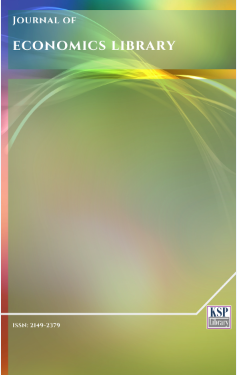Modelling dynamics of inflation in Nigeria
Abstract
Abstract. The study was motivated by the pervasively increasing inflation rate which has for the past 3 decades embattled and inhibited the potential growth of the Nigeria economy coupled with the fact that empirical studies on modeling the trend and behavior of inflation dynamics have remained largely neglected or scarcely researched. Hence, the pertinent concern of this paper is to model the dynamics of inflationary expectation in Nigeria by applying autoregressive distributed lag (ARDL) cointegration framework, Error Correction model, Ordinary Least Square methods and a host of diagnostic tests on time series (secondary) data, covering 1980 to 2015. While the empirical results expedite a cointegrated and stable long-run relationship between the variable of interests when price level is the dependent variable, money supply, interest rates, fiscal deficit to GDP and international oil price shock are found to be statistically significant in explaining the dynamics of inflation in Nigeria both in the long run and short run. Consequently, the study recommends the need for implementation of strategic diversification policy to reduce the vulnerability of the economy to oil price shock both locally and internationally and also, that the government and policymakers need to swing into urgent action in initiating fiscal policy that will further enhance stabilization of the country’s exchange rate and raise the value of the Naira.
Keywords. Exchange rate, Industrialization, Export, Inflation.
JEL. L00, L16, F31.
Keywords
References
Ajakaiye, O. (2008). Fiscal and monetary policy coordination in an inflation, Proceeding of The One-Day Seminar on Monetary Policy and Inflation targeting. January 19, pp.89-99.
Bechmann, R., Berg, T.O., & Sims, E.R. (2015). Inflation expectation and readiness to spend: Cross-sectional evidence, American Economic Journal: Economic Policy, 7(1), 1-33. doi. 10.1257/pol.20130292
Blanchard, O. (2005). Fiscal dominance and inflation targeting, in F. Giavazzi, I. Ggoidfajn, & S. Herra, (Eds), Inflation Targeting, Debt and The Brazilian Experience, 1999 to 2003. Cambridge, MA: MIT Press.
Blanchard, O., Cerutti, E., & Summers, L. (2015) Inflation and activity-two explorations and their monetary implications. IMF, Working Paper Series, No.WP/15/230: 7-29. [Retrieved from].
Buffies, E. (2003). Tight money, interest rates, and inflation in Africa, IMF, Staff Papers, 50(1), 115-135. [Retrieved from].
Buffies, E., Adam, E.C., O’ Connell, S., & Pattillo, C. (2008). Riding the wave, monetary responses to aid surge in low-income countries, European Economic Review, 52(8), 1378-1395. doi. 10.1016/j.euroecorev.2008.02.001
D’Acunto, F., Hoang, D., & Webler, M. (2015). Inflation expectation and consumption expenditure, Chicago Booth Global Market Working Paper Series. [Retrieved from].
Duca, I., Kenny, G., & Reuter, A. (2016). How to do inflation expectations impact consumer behaviour, European Central Bank Working Paper, [Retrieved from].
Harris, R., & Sollis, R. (2003). Applied Time Series Modelling and Forecasting. Wiley, West Sussex.
Ichiue, H., & Nishigushi, S. (2015). Inflation expectations and consumer spending at zero bound: Macro evidence, Economic Inquiry, 53(2), 1086-1107. doi. 10.1111/ecin.12176
Mounir B., (n.d.). The relationship between trade, FDI and economic growth in Tunisia: An application of the autoregressive distributed lag model. Faculty of Economics and Management of Sousse, University of Sousse City Erriadh 4023 Sousse Tunisia.
Narayan, P.K., & Smyth, R. (2008). Energy consumption and real GDP in G7 countries: New evidence from panel cointegration with structural breaks, Energy Economics, 30, 2331-2341. doi. 10.1016/j.eneco.2007.10.006
O’Connell, S. (2008). Inflation targeting as a monetary policy framework: Issues and concerns, Proceeding of The One-Day Seminar on Monetary Policy and Inflation targeting. January 19, pp.9-33.
Odhiambo, N.M. (2009). Energy consumption and economic growth in Tanzania: An ARDL bounds testing approach, Energy Policy, 37(2), 617-622. doi. 10.1016/j.enpol.2008.09.077
Oyejide, T.A. (1972). Deficit financing and capital formation: An analysis of Nigerian experience, Journal of Economic and Social Studies, 27-43.
Pesaran, M., & Shin, Y. (1999). An autoregressive distributed lag modeling approach to cointegration analysis, in S. Strom, (ed), Econometrics and Economic Theory in the 20th Century: The Ragnar Frisch Centennial Symposium, Cambridge University Press, Cambridge.
Pesaran, M.H., Shin, Y., & Smith, R.J. (2001). Bounds testing approaches to the analysis of the level relationship. Journal of Applied Economics, 16, 289-326. doi. 10.1002/jae.616
DOI: http://dx.doi.org/10.1453/jel.v5i3.1701
Refbacks
- There are currently no refbacks.
.......................................................................................................................................................................................................................................................................................................................................
Journal of Economics Library - J. Econ. Lib. - JEL - www.kspjournals.org
ISSN: 2149-2379
Editor: [email protected] Secretarial: [email protected] Istanbul - Turkey.
Copyright © KSP Library

